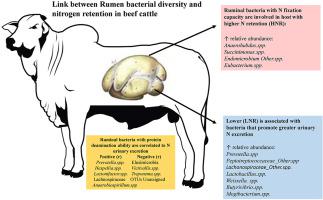Anaerobe ( IF 2.3 ) Pub Date : 2020-12-29 , DOI: 10.1016/j.anaerobe.2020.102316 Kênia Larissa Gomes Carvalho Alves 1 , Yury Tatiana Granja-Salcedo 2 , Juliana Duarte Messana 1 , Vinícius Carneiro de Souza 3 , Maria Júlia Generoso Ganga 1 , Paulo Henrique Detogni Colovate 1 , Luciano Takeshi Kishi 4 , Telma Teresinha Berchielli 5

|
This study aimed to characterize the rumen bacterial diversity of beef steers differing in the efficiency of nitrogen retention (ENR). Eight castrated steers and fitted with ruminal silicone - and duodenal T-type cannulas were used in a cross-over design with three consecutive periods and three diets. During each experimental period, nitrogen balance was measured, and based on the efficiency of N utilization data, steers were split into three ENR groups: high (HNR, 56.6% ± 3.3%, n = 10), medium (MNR, 45.8% ± 2.2%, n = 6), and low (LNR, 37.7% ± 1.9%, n = 8) using the NbClust package version 2.0.4 in R. Prevotellaceae, Lactobacillaceae, Leuconostocaceae, Clostridiales_Incertae_Sedis_XIII, Lachnospiraceae, and Peptostreptococcaceae were more abundant in LNR (P < 0.05) compared to HNR or MNR. Negative correlations were found between N retention and Mogibacterium, Anaerofustis, Butyrivibrio, Coprococcus, Hespellia, Lactonifactor and Lachnospiraceae (r ≤ −0.61; P ≤ 0.05). Prevotella, Hespellia, Lactonifactor, Lachnospiraceae_other, and Anaerobiospirillum were positively correlated between urinary N excretion (r > 0.55; P < 0.01), and negative correlations were found with Elusimicrobia, Victivallis and Treponema (r < −0.41; P < 0.05). The adjustment of the rumen bacterial community differed significantly between the N use retention groups. The high N retention in beef cattle was associated with less abundant bacteria in the rumen; however, N fixation capacity and uncharacterized rumen microorganisms need to be elucidated in future studies. In contrast, lower N utilization was associated with high abundance of bacteria that promote greater urinary N excretion through ruminal protein degradation.
中文翻译:

与肉牛氮保留相关的瘤胃细菌多样性
本研究旨在表征不同氮保留效率 (ENR) 的牛肉的瘤胃细菌多样性。八头阉割公牛并装有瘤胃硅胶和十二指肠 T 型插管,用于交叉设计,连续三个时期和三个饮食。在每个实验期间,测量氮平衡,并根据氮利用效率数据,将阉牛分为三个 ENR 组:高(HNR,56.6% ± 3.3%,n = 10),中(MNR,45.8% ± 2.2%,ñ = 6),和低(LNR,37.7%±1.9%,ñ 在R.使用NbClust包2.0.4版= 8)Prevotellaceae,乳杆菌科,Leuconostocaceae,Clostridiales_Incertae_Sedis_XIII,毛螺,和 与 HNR 或 MNR 相比,消化链球菌科在 LNR 中的含量更高(P < 0.05)。发现 N 保留与Mogibacterium、Anaerofustis、Butyrivibrio、Coprococcus、Hespellia、Lactonifactor和Lachnospiraceae之间呈负相关(r ≤ -0.61;P ≤ 0.05)。Prevotella、Hespellia、Lactonifactor、Lachnospiraceae_other和Anaerobiospirillum与尿N排泄呈正相关(r >0.55;P <0.01),与Elusimicrobia、Victivallis和Treponema呈负相关(r < -0.41;P < 0.05)。N使用保留组之间瘤胃细菌群落的调整显着不同。肉牛的高氮保留与瘤胃中较少的细菌有关;然而,需要在未来的研究中阐明固氮能力和未表征的瘤胃微生物。相比之下,较低的氮利用率与高丰度的细菌有关,这些细菌通过瘤胃蛋白质降解促进更多的尿氮排泄。


























 京公网安备 11010802027423号
京公网安备 11010802027423号